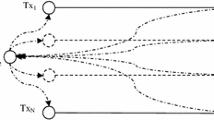Abstract
In this paper we describe a fuzzy-control approach for quality of service (QoS) adaptation, needed in distributed multimedia applications. QoS adaptation is necessary (a) due to sudden variations in network resource availability, especially in the case of Internet, and (b) due to multiple applications requiring shared resource such as bandwidth. To solve the problem of QoS adaptation, several sub-problems need to be considered: (1) mapping of user perception and different combinations of application QoS values onto a uniform quality metric, (2) estimation, control and adjustment of application QoS parameters in case of network and other resource congestion, and (3) enforcement algorithm which reacts according to adapted QoS parameters. Our approach is to solve the QoS adaptation using the integration of (a) quality degree function, which maps the application QoS parameters into a metric, called quality degree, (b) fuzzy controller, which controls, estimates and adjusts the application QoS parameters according to resource availability, and (c) filter algorithms, which are the services to enforce the adapted QoS parameters. The quality degree function associates quality degree as the quality measure with different combinations of application QoS values. This function is influenced by the user’s perception of quality. The fuzzy control takes the results of the quality degree function, estimates the new quality degree and its corresponding quality level, predicts the new application QoS parameters, and adjusts them. The results of the adapted QoS parameters are then used by the filter algorithms to enforce the changes, proposed by the fuzzy controller, by allocating bandwidth to the application according to its QoS parameter values. We have implemented and applied the quality degree function, the fuzzy controller, and the filter algorithms to the video distribution system (VDS). The results of VDS over the local area network show that (1) the target system improves user perceived QoS at the receivers, and (2) the bandwidth utilization increases significantly when using our fuzzy-control approach for QoS adaptation.
Similar content being viewed by others
References
Abdelzaher, T., and Shin, K. G. 1998. End-host architecture for QoS-adaptative communication. In IEEE 4th Real-Time Technology and Applications Symposium. Denver, Colorado, USA.
Bezdek, J. C. 1981. Pattern Recognition with Fuzzy Objective Function Algorithms. Plenum Press.
Busse, I., Deffner, B., and Schulzrinne, H. 1995. Dynamic QoS of multimedia applications based on RTP. In 1st International Workshop on High Speed Networks and Open Distributed Platforms. St. Petersburg, Russia.
Correa, C. 1999. The use of genetic controllers for fuzzy controller construction used by artificial satellite height control during the appointment phase. Master's thesis, National Spatial Research Institute, São Josè dos Campos, Brazil. In Portuguese.
Cottrell, L., Matthews, W., and Logg, C. 2000. Tutorial on internet monitoring and PingER at SLAC. Technical report, University of Stanford, USA.
Dubois, D., and Prade, H. 1988. Representation and combination of uncertainty with belief functions and possibility measures. Computational Intelligence 4(3): 244-264.
Fukuda, K., Wakamiya, N., Murata, M., and Miyahara, H. 1997. QoS mapping between user's preference and bandwidth control for video transport. In IFIP 5th International Workshop on Quality of Service (IWQoS'97). New York, USA, pp. 291-301.
Gall, D. L. 1991. MPEG: A video compression standard for multimedia applications. Communication of the ACM, 34(4).
Ghinea, G., and Thomas, J. 1998. QoS impact on user perception and understanding of multimedia video clips. In 6th ACM International Conference on Multimedia (Multimedia '98). Bristol, England, pp. 49-54.
Hull, D., Shankar, A., Nahrstedt, K., and Liu, J. W. S. 1997. An end-to-end QoS model and management architecture. In IEEE Workshop on Middleware for Distributed Real-Time Systems and Services. San Francisco, USA, pp. 82-89.
International Telecommunication Union. Recommendation ITU-T P.800. 1996. Methods for Subjective Determination of Transmission Quality.
Jantzen, J. 1998. Design of fuzzy controllers. Technical Report TR 98-E-864, Technical University of Denmark, Lyngby, Denmark.
Koliver, C. 2001. An Approach for QoS Adaptation Based on Fuzzy Control. PhD thesis, Federal University of Santa Catarina, Florianópolis, Brazil. In Portuguese.
Koliver, C., and Farines, J.-M. 2001. A fuzzy controller for QoS adaptation. In XIX Brazilian Symposium on Computer Networks (SBRC'2001), Florianópolis, Brazil, pp. 33-49. In Portuguese.
Krasic, C., and Walpole, J. 1999. QoS scalability for streamed media delivery. Technical Report CSE-99-011, Oregon Graduate Institute os Science and Technology, Oregon, USA.
Lakshman, V., Misshra, P. P., and Ramakrishnan, K. K. 1997. Transporting compressed video over ATM networks with explicit rate feedback control. In IEEE INFOCOM'97, Kobe, Japan, pp. 38-47.
Li, B., and Nahrstedt, K. 1999. A control-based middleware framework for quality of service adaptation. IEEE Journal on Selected Areas in Communications (JSAC) 17(9): 1632-1650.
Mamdani, E. H., and Baaklini, N. 1975. Prescriptive method for deriving control policy in a fuzzy logic controller. Eletronic Letters 11: 625-626.
N.G. Duffield, K. R. A. R. 1998. SAVE: an algorithm for smoothed adaptive video over explicit rate networks. IEEE Transactions on Networking 6(6): 717-728.
Sisalem, D. 1998. Fairness of adaptive multimedia applications. In IEEE International Conference on Communications (ICC'98), Atlanta, USA.
Sisalem, D., and Schulzrinne, H. 2000. The Direct Adjustment Algorithm: a TCP-Friendly Adaptation Scheme. In 1st International Workshop Quality of Future Internet Services (QofIS'2000), Berlin, Germany.
Skogestad, S., and Postlethwait, I. 1996. Multivariable Feedback Control: Analysis and Design. John Wiley and Sons.
Takagi, T., and Sugeno, M. 1985. Fuzzy identification of systems and its applications to modeling and control. IEEE Transactions on Systems, Man and Cybernetics 15(1): 116-132.
Vogel, A., Kerherv, B., von Bochmann, G., and Gecsei, J. 1995. Distributed multimedia applications and quality of service: a survey. IEEE MultiMedia 2(2): 10-19.
Yeadon, N., Garcia, F., Hutchinson, D., and Mauthe, A. 1996. Filters QoS support mechanisms for multipeer communications. IEEE Journal on Selected Areas in Communications (JSAC) 14(7): 1245-1262.
Zadeh, L. A. 1965. Fuzzy sets. Information & Control N/A (8): 338-353.
Author information
Authors and Affiliations
Rights and permissions
About this article
Cite this article
Koliver, C., Nahrstedt, K., Farines, JM. et al. Specification, Mapping and Control for QoS Adaptation. Real-Time Systems 23, 143–174 (2002). https://doi.org/10.1023/A:1015302604246
Issue Date:
DOI: https://doi.org/10.1023/A:1015302604246




